Search the Special Collections and Archives Portal
Search Results
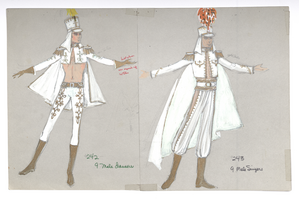
Males in white military-like costumes for Pzazz! 67, Las Vegas, Nevada: costume design drawing
Date
Archival Collection
Description
Hand written next to the male figure on the left: "242, 9 male dancers." Hand written next to the male figure on the right: "243, 9 male singers."
Costume Details: Two male performers wearing gold and white military-like costumes. On the left, the male dancer is wearing a short white jacket complete with golden designs, gloves, and fringed shoulder pads. For bottoms , the male is sporting white pants decorated with gold patterns across the thighs and a matching gold belt and pair of boots. He is also wearing a white, gold-lined cape and matching hat that has a yellow feather sticking out of the top of it. On the right is the design for the male singer, whose costume looks almost alike to the dancer, except for a few minor adjustments. For the singer, he is wearing white pants with a thigh high slit down the side, no gloves, and a matching white and gold hat with a feather sticking out of the top of it.
Show Name: Pzazz! 67
Performance Name: Salute to Beau Geste
Image
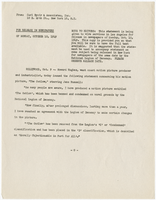
Press release regarding the reclassification code of the motion picture "The Outlaw"
Date
Description
Text
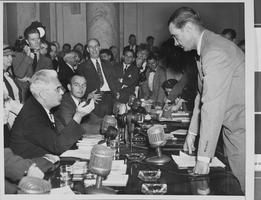
Photograph of Howard Hughes at hearing, Washington, August 08, 1947
Date
Archival Collection
Description
Image
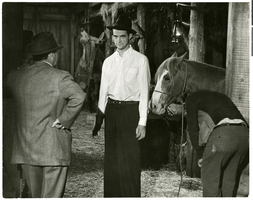
Photograph of Howard Hughes with Jules Furthman on the set of The Outlaw, Hollywood, circa 1941
Date
Archival Collection
Description
Image
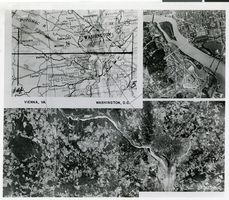
Aerial photograph of Potomac area, with map, demonstrating the Lockheed Shooting Star mapping plane, October 28, 1946
Date
Archival Collection
Description
Image
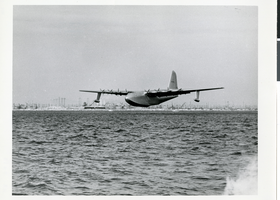
Photograph of Hughes Flying Boat during its test flight, November 2, 1947
Date
Archival Collection
Description
Image
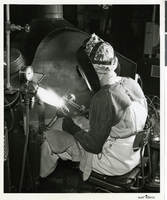
Photograph of new atomic-hydrogen welding process, Hughes Tool Company, Houston, Texas, circa 1929
Date
Archival Collection
Description
Image
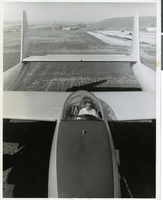
Photograph of Howard Hughes sitting in the cockpit of the XF-11 preparing for his first test flight in Culver City, California July 7, 1947
Date
Archival Collection
Description
Image
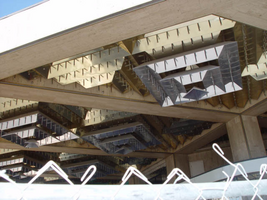
neo000044-004
Description
Notes: The logo cabinets which adorn the entrances on the elevated walkways: The letters start with both rows of text in the off position. The top row flashes on, while the bottom row is dark then the bottom row illuminates, as the top row goes dark. Once the top row flashes off it flashes back on so that both rows of text are briefly illuminated simultaneously before they both go dark and the sequence stars over again. While this is going on the incandescent bulbs which line all of the raceways are chasing each other from left to right on the horizontal planes, while the arched sections chase each other downward. The triangular peaks which radiate around the top of the logo sign, flash on and off in a sequence which chase each other downward. First the top center peak flashes on, then the next sequential triangular channel on both sides illuminate simultaneously, flash off, then the next two in the series illuminate. The resultant effect is a chasing pattern starting from the top. The sister animation is located on almost the exact same design on the porte cochere. I would think the previous smaller sign would be based on the larger porte cochere. The other variance besides obvious size difference is the that the channel letters are filled with incandescent bulbs instead of neon. The animation is a bit simpler as well. The incandescent bulbs oscillate continuously while the triangular pan channels which create the radiating crown, animate. The neon in the channels chase each other as described in the smaller walk way version, while the text continues until the entire text flashes off, then on, off, then begin to animate once again. All of the bulbs, which line the raceways of the exterior edge of the porte cochere, as well as the encrustation of bulbs on the brass bull nose portion, animate in rapid succession. All the raceway bulbs chase each other while the bulbs on the brass portion continually oscillate. Animation continues on the east face of the building with the entrances first. The principle for these two signs is oscillation and chasing. All bulbs on the underside of the entrance, as well as in the logo, oscillate rapidly. All bulbs on the raceways chase each other. Further on the surface of the building as well, the Pepsi cola wall sign is found displaying a very unique form of animation, seen here on the strip. The signage for the Pepsi ad is located on the eastern wall. (Detailed in specific description) The Incandescent bulbs which fill the inside of the text that spells Pepsi, chase each other from left to right, leaving all the bulbs in its path illuminated, as if writing out the word Pepsi. The neon bars located within the tilted bottle of Pepsi are illuminated, and chase each other downward, leaving the bars it its path dark. As this sequence in taking place, the waving tubes of neon illuminate, flashed subtly making the neon appear as soda pouring out of the bottle. As the tubing flows then the vertical neon bars in the cup illuminate one at a time making the cup appear as if it is filling up. The text above each of the painted fires head, flashes back and forth as if talking to each other as well. ESPN ZONE animation: The letters in the vertical blade portion of the ESPN Zone illuminate one at a time, starting from the top. Once the entire phrase is lit, in flashes off then on then off, before restating. The orange and red neon tubing which resides inside the pan channels that represent flames flash on and off in a relaxed manner as if to animate the flickering of the flames. The small incandescent bulbs on the black portions above the main matrix reader board flash on and off subtly.

